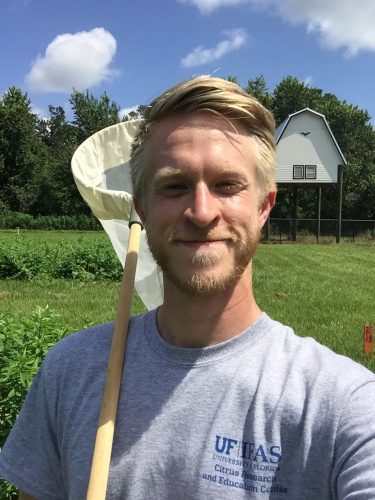
Jon Elmquist, M.S.
Insect Conservation Technician
E-mail: elmquistj@ufl.edu
Twitter: @elm_branch
Instagram: @elm_branch
As an Insect Conservation Technician, Jon supports the lab’s efforts to help conserve imperiled butterflies and bees, including monitoring of insect flower visitors, captive rearing and releases of at-risk butterflies, and augmentation of retention basins with milkweed and nectar plants for monarch butterflies. Jon earned his bachelor’s degree in biology from the University of Central Florida in 2015 and his master’s degree in entomology from Penn State in 2022, where he studied risk to pollinators from neonicotinoid insecticides applied to red maple and tree-of-heaven for management of the spotted lanternfly under the advisement of Drs. Kelli Hoover and David Biddinger. Jon’s previously worked as a research technician in the labs of Drs. Jamie Ellis and Rachel Mallinger at the University of Florida, managing apiaries, assisting projects on honey bee husbandry and pollinator ecology, and educating audiences about bees through extension. His professional interest with pollinator conservation and education began when he was a cast member at Disney’s Animal Kingdom, where he was given opportunities to monitor butterfly populations and engage park guests about insects and their importance. Outside of his work, Jon likes to spend time with family and friends, listen to and write metal and hardcore music, learn philosophy, eat good foods, and enjoy the beauty of nature.
Publications:
Elmquist, J., D. Biddinger, N. T. Phan, T. W. Moural, F. Zhu, and K. Hoover. 2023. Potential risk to pollinators from neonicotinoid applications to host trees for management of spotted lanternfly, Lycorma delicatula (Hemiptera: Fulgoridae). Journal of Economic Entomology. toad032.
Elmquist, J., K. Hoover, and D. Biddinger. 2023. Insect floral visitors of red maple and tree-of-heaven at potential risk of neonicotinoid residue exposure from spotted lanternfly control. The Great Lakes Entomologist. 55(2): 4.